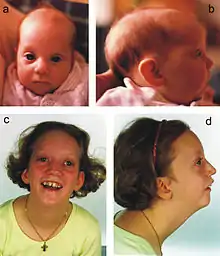Micrognathism
Micrognathism is a condition where the jaw is undersized. It is also sometimes called mandibular hypoplasia. It is common in infants, but is usually self-corrected during growth, due to the jaws' increasing in size. It may be a cause of abnormal tooth alignment and in severe cases can hamper feeding.[2] It can also, both in adults and children, make intubation difficult, either during anesthesia or in emergency situations.

| Micrognathism | |
|---|---|
| Other names | Micrognathia, strawberry chin, hypognathia[1] hypognathism |
 | |
| Girl with Wolf–Hirschhorn syndrome | |
| Specialty | Medical genetics |
Causes
While not always pathological, it can present as a birth defect in multiple syndromes including:
- Catel–Manzke syndrome[3]
- Bloom syndrome
- Coffin–Lowry syndrome
- Congenital rubella syndrome
- Cri du chat syndrome
- DiGeorge syndrome
- Ehlers–Danlos syndrome
- Fetal alcohol syndrome
- Hallermann–Streiff syndrome
- Hemifacial microsomia (as part of Goldenhar syndrome)
- Incontinentia pigmenti
- Juvenile idiopathic arthritis
- Marfan syndrome
- Möbius syndrome
- Noonan syndrome
- Pierre Robin syndrome
- Prader–Willi syndrome
- Progeria
- Silver–Russell syndrome
- Seckel syndrome
- Smith–Lemli–Opitz syndrome
- Stickler syndrome
- Treacher Collins syndrome
- Trisomy 13 (Patau syndrome)
- Trisomy 18 (Edwards syndrome)
- Trisomy 21 (Down syndrome)
- Wolf–Hirschhorn syndrome
- X0 syndrome (Turner syndrome)
Diagnosis
It can be detected by the naked eye as well as dental or skull X-Ray testing.
Treatments
Micrognathia can be treated by surgery,[4] orthodontic braces,[5] and modified eating methods. Early detection of the problem and monitoring as the problems grows can help understand it better and find the most effective treatment procedure.
See also
References
- Martínez-Frías, ML; Martín, M; Pardo, M; Torres, M; Cohen MM, Jr (1993). "Holoprosencephaly and hypognathia with two proboscides: report of a case and review of unusual proboscides". Journal of Craniofacial Genetics and Developmental Biology. 14 (4): 231–4. PMID 7883869.
- Hong, Paul; Brake, Maria K.; Cavanagh, Jonathan P.; Bezuhly, Michael; Magit, Anthony E. (2012). "Feeding and mandibular distraction osteogenesis in children with Pierre Robin sequence: A case series of functional outcomes". International Journal of Pediatric Otorhinolaryngology. 76 (3): 414–418. doi:10.1016/j.ijporl.2011.12.023. ISSN 0165-5876. PMID 22245167.
- Rajendran A; Sundaram S (10 February 2014). Shafer's Textbook of Oral Pathology (7th ed.). Elsevier Health Sciences APAC. pp. 12–13. ISBN 978-81-312-3800-4.
- Acacius, Hubris. "Macrognathia and Micrognathia: What are they?". SupreDent. Retrieved March 13, 2022.
- "What Is Micrognathia?". Healthline. Retrieved March 13, 2022.
External links
- "Micrognathia". Medline Plus. 12 May 2009. Retrieved 21 May 2011.